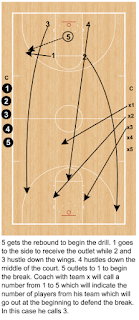Player Development Overview
One of my favorite parts of coaching is the actual development of players. In the many years I have spent coaching, I have had the pleasure to coach kids who were willing to put in the work and who saw benefits from it. My job as skills coach is to keep the players improving. We have spoken before about getting players to go beyond their comfort zone into an area of the unknown. An area that may seem awkward to them at the beginning but with constant reps will get easier and more instinctive. The area of unknown has to be very carefully determined. The area identified can't be too difficult for the kids to perform or else they can get discouraged. On the other hand, the area can't be too easy as to not challenge the kids. In order to do this properly there is a sequence that needs to be followed. The sequence is challenge, evaluate, adjust, execute, and repetition.
The first step of the sequence is to challenge. Set up some basic drills that are challenging enough for beginners but relatively easy for everyone else. This will let you see right away who can and can't do specific drills and will help you gauge what kind of drills you will be doing for the rest of the skills camp.
The second criteria is evaluation. This criteria is so important because if you improperly evaluate a player, he won't benefit from the opportunity presented to him as much as he should. To do this properly, coaches need to avoid getting attached to players. Stay neutral with all player and this will help you help them properly.
The third criteria is adjust your plan to the personnel you have. If your evaluation is showing that you have an advanced group of kids then you might need to raise the level of difficulty a few notches. If, however, the quality of play is below expectations you may need to slow things down. Always be prepared to adjust to your personnel.
The next criteria is execution. Always hold your kids accountable. Make them do the drills properly. Always push them but do it in a positive fashion. Remember that at the youth level, you are nurturing and trying to build confidence. Don't drive them away by being too demanding.
The final point of emphasis is about repetition. Getting reps is very important. Doing something once or twice is not going to cut it. You need to take thousands of quality reps in order for the player to commit his new found skills to memory. This isn't all going to happen in your camp but you need to make sure that when the kids leave they will have the basic idea of how the skill needs to be done. This way when they practice after the camp, they know what they need to do, to properly stack the reps needed to reach their goal.
In closing, the five criteria I mentioned above are good ways to run a skills camp in a fashion which will benefit all participants. In addition to the above criteria, you should also keep in mind that camp size is important also. If you have one instructor for 30 kids then it's a money grab, not instruction. There need to be enough people there where you can differentiate if you have to. The best ration is 1 coach for 4 people maybe 5 max. The next time you take your kid to instruction look and see how many people are actually running the camp, if there aren't enough coaches there then look for something better.



Comments
Post a Comment